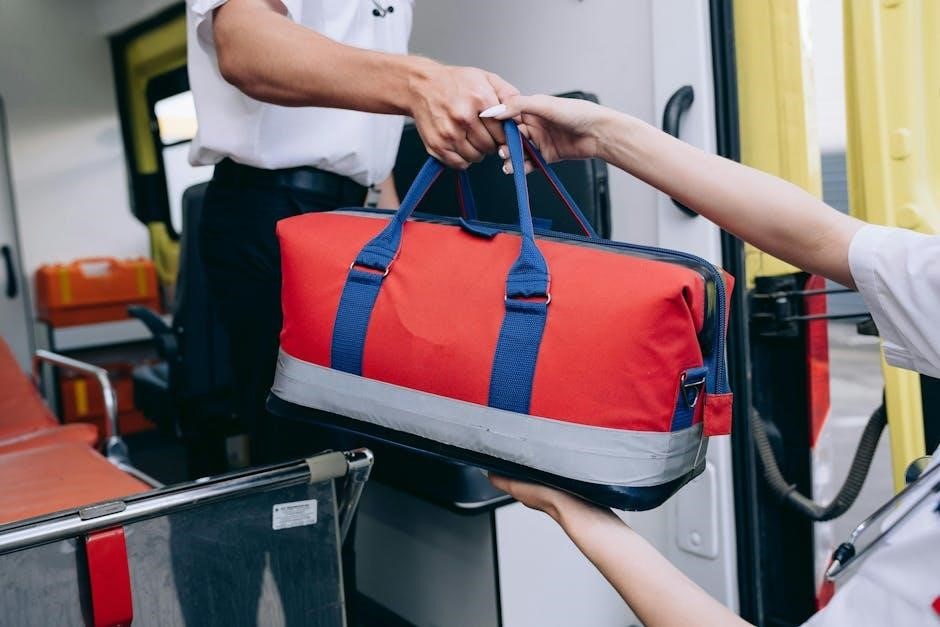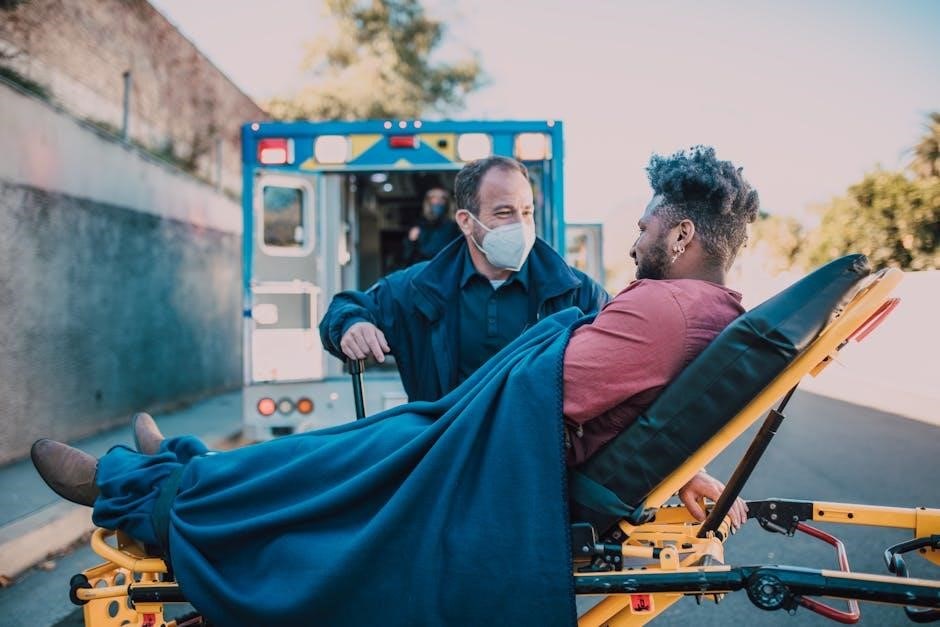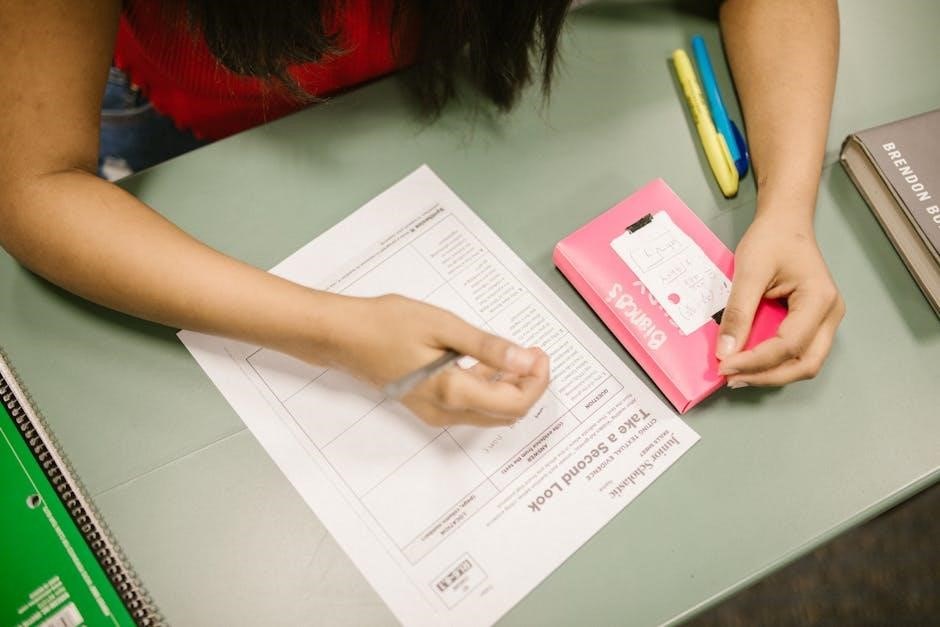st john first aid quiz questions and answers pdf
The St John First Aid Quiz Questions and Answers PDF provides essential resources for first aid training, offering 10 key questions on emergency response, CPR, and wound care procedures.
Overview of the Importance of First Aid Training
First aid training is crucial for equipping individuals with the skills to respond effectively during medical emergencies. It empowers people to act confidently, reducing risks and preventing minor injuries from worsening. Knowledge of first aid ensures timely intervention, which can be lifesaving in critical situations. Regular training updates individuals on the latest guidelines, ensuring they stay informed and capable. First aid is not just for medical professionals; it is a vital skill for everyone, fostering a safer community. By understanding proper techniques, such as wound care and CPR, individuals can make a significant difference in emergencies. This training promotes preparedness, enabling people to act decisively and responsibly.
Why St John First Aid Quizzes Are Essential for Preparation
St John First Aid quizzes are vital for effective preparation, as they assess knowledge and practical skills in real-time. These quizzes cover essential topics like emergency response, CPR, and wound care, ensuring comprehensive understanding. By simulating exam conditions, they help build confidence and readiness for actual scenarios. The quizzes are engaging, with challenging questions that keep learners motivated. They also highlight areas needing improvement, allowing focused study. Regular practice through these quizzes enhances retention and ensures proficiency in life-saving techniques. Thus, they are indispensable for anyone aiming to master first aid skills and apply them effectively in critical situations.
Key Features of the St John First Aid Quiz Questions and Answers PDF
The St John First Aid Quiz Questions and Answers PDF is a comprehensive resource designed to enhance first aid knowledge and practical skills. It includes 10 essential questions covering critical topics such as emergency response, CPR techniques, and wound care. The document provides clear, concise answers to each question, ensuring clarity and understanding. Additionally, it incorporates practical assessments to evaluate hands-on skills like bandaging and bleeding control. The PDF is user-friendly, with a structured format that makes it easy to navigate and study. It serves as an invaluable tool for individuals preparing for first aid certification or seeking to refresh their knowledge. Regular use of this resource helps build confidence and ensures readiness in real-life emergencies.

Structure of the St John First Aid Quiz
The St John First Aid Quiz features 10 multiple-choice questions covering emergency responses, CPR, and wound care. Practical assessments are included for bandaging and bleeding control.
Types of Questions Included in the Quiz
The St John First Aid Quiz includes multiple-choice questions, true/false statements, and fill-in-the-blank exercises. These cover essential first aid topics such as emergency response procedures, CPR techniques, and wound care. Practical assessments evaluate skills like bandaging and bleeding control. The questions are designed to test both theoretical knowledge and practical application, ensuring comprehensive understanding. This variety helps learners prepare for real-life scenarios effectively.
Time Limits and Format of the Quiz
The St John First Aid Quiz typically has a time limit of 30 minutes to complete 20-25 questions, ensuring participants can demonstrate their knowledge effectively. The quiz is divided into multiple sections, including theoretical questions and practical scenario-based exercises. The format includes multiple-choice questions, true/false statements, and short-answer responses. Practical assessments, such as CPR and bandaging techniques, are also timed to simulate real-life emergency situations. This structured approach ensures that participants can apply their knowledge under pressure, preparing them for actual first aid emergencies. The clear format and time constraints make the quiz an effective tool for evaluating readiness and understanding of first aid principles.
Scoring System and Evaluation Criteria

The St John First Aid Quiz uses a scoring system where each question carries equal weight, with 1 point awarded for correct answers and 0.5 points deducted for incorrect ones; Participants must achieve a minimum of 80% to pass. The evaluation criteria focus on accuracy, understanding of first aid principles, and the ability to apply knowledge in real-life scenarios. Practical assessments are scored based on technique and adherence to guidelines. Feedback is provided to highlight strengths and areas for improvement, ensuring comprehensive learning and preparedness for emergency situations. This system ensures that participants demonstrate both theoretical knowledge and practical proficiency in first aid.

Content Covered in the St John First Aid Quiz
The quiz covers essential first aid topics, including medical emergencies, injury management, CPR techniques, wound care, burns, choking relief, and bleeding control, ensuring comprehensive preparedness for emergencies.
Medical Emergencies and Response Techniques
Medical emergencies require immediate and effective responses to ensure the best outcomes. The St John First Aid Quiz covers critical scenarios like heart attacks, strokes, seizures, and severe allergic reactions. It emphasizes the importance of recognizing symptoms, such as chest pain, difficulty breathing, or loss of consciousness, and taking appropriate actions. The quiz also includes questions on the proper use of techniques like the SAMPLE history-taking method to assess patients effectively. Additionally, it addresses response strategies, such as prioritizing care for multiple casualties and maintaining patient stability until professional help arrives. These questions help learners master practical skills and confidence in handling life-threatening situations, ensuring they can act decisively and safely in real-world emergencies.
Injury Management and Wound Care
Injury management and wound care are vital components of first aid training, focusing on preventing infection and promoting healing. The St John First Aid Quiz includes questions on assessing injuries, cleaning wounds, and applying appropriate dressings. It covers techniques for controlling bleeding, such as direct pressure and elevation, as well as identifying signs of infection, like redness or swelling. The quiz also addresses scenarios involving burns, scalds, and lacerations, emphasizing the importance of using sterile materials and avoiding excessive use of antiseptics. Additionally, it explores bandaging methods and splinting techniques to immobilize injuries effectively. These questions ensure learners can confidently manage various injuries, from minor cuts to more severe wounds, while minimizing complications and supporting recovery.
CPR and Automated External Defibrillator (AED) Usage
CPR and AED usage are critical skills in first aid, essential for saving lives during cardiac emergencies. The St John First Aid Quiz emphasizes proper CPR techniques, including chest compressions, rescue breaths, and depth ratios. It also covers AED operation, such as turning on the device, attaching pads, and delivering shocks. Questions address scenarios like unresponsive victims, cardiac arrest recognition, and when to use an AED. The quiz ensures learners understand the importance of minimizing interruptions during CPR and following AED voice prompts. Mastery of these skills is vital for increasing survival rates and improving outcomes in life-threatening situations. Practical training and regular updates on guidelines are strongly encouraged to maintain proficiency.
Bandaging and Splinting Techniques
Bandaging and splinting are fundamental first aid skills covered in the St John First Aid Quiz. The quiz includes questions on selecting the right type of bandage, such as elastic or adhesive, and proper application techniques. It also addresses splinting methods to immobilize injuries, providing support for fractures or sprains. Key topics include how to secure bandages without restricting circulation and the use of splints to prevent further injury. Practical scenarios, like immobilizing broken limbs or managing open wounds, are emphasized. The quiz ensures learners understand the importance of proper bandaging to promote healing and reduce infection risks. Regular practice and adherence to updated first aid guidelines are crucial for mastering these techniques effectively.
Burns and Scalds First Aid
The St John First Aid Quiz covers critical techniques for treating burns and scalds. Questions focus on immediate actions, such as stopping the burning process with cool water and removing clothing or jewelry near the affected area. The quiz emphasizes the importance of not using ice or breaking blisters. Different types of burns, such as superficial, partial-thickness, and full-thickness burns, are addressed, along with appropriate care methods. Prevention strategies, like avoiding hot surfaces and using protective gear, are also included. The quiz ensures learners understand when to seek professional medical help, such as for severe burns or those covering large body areas. Proper wound care and infection prevention are highlighted to promote healing and reduce complications.
Choking and Airway Obstruction Relief
The St John First Aid Quiz emphasizes techniques to relieve choking and airway obstructions. Questions cover identifying signs of choking, such as inability to speak or breathe, and appropriate first aid actions. For adults and children, the quiz highlights the use of back blows and abdominal thrusts to dislodge obstructions. It distinguishes between techniques for conscious and unconscious individuals, stressing the importance of seeking immediate medical help if the person becomes unresponsive. The quiz also addresses prevention strategies, such as avoiding eating or talking with the mouth full and cutting food into small pieces for children. Proper demonstration of these techniques is crucial for effective airway clearance and preventing complications like brain damage from lack of oxygen.
Head Injuries and Concussion Management

The St John First Aid Quiz includes critical questions on managing head injuries and concussions. It highlights the importance of assessing the individual’s level of consciousness using the AVPU scale and recognizing signs of a concussion, such as dizziness, confusion, or nausea. The quiz emphasizes immediate actions, like immobilizing the head and neck to prevent further injury and controlling bleeding from superficial wounds. It also addresses when to seek professional medical help, especially if symptoms worsen or if there is a loss of consciousness. The quiz underscores the need to monitor for complications, such as swelling or neurological deficits, and provides guidance on comforting the individual and avoiding unnecessary movement. Proper management techniques are vital to prevent long-term effects and ensure recovery.
Bleeding Control and Shock Prevention
The St John First Aid Quiz addresses critical techniques for controlling bleeding and preventing shock. It emphasizes the importance of immediately assessing the severity of the injury and applying direct pressure using a clean cloth or dressing. Elevating the affected limb above heart level, if possible, is also highlighted as an effective method to reduce blood flow. The quiz includes questions on proper tourniquet application for severe bleeding and the signs of shock, such as pale skin, rapid heartbeat, and fainting. It stresses the need to keep the individual calm, comfortable, and warm to prevent shock from worsening. The quiz also covers when to seek immediate medical attention, ensuring prompt intervention for life-threatening situations. Proper bleeding control and shock prevention are essential skills to save lives and prevent further complications.

Fractures and Sprains First Aid
The St John First Aid Quiz covers essential first aid techniques for fractures and sprains, focusing on immediate care to prevent further injury. For fractures, immobilization is key, often using splints, while sprains require rest, ice, compression, and elevation (RICE method). The quiz highlights the importance of avoiding movement of the affected limb to prevent further damage. Assessing the severity of the injury and recognizing signs like numbness or discoloration is crucial for determining the need for medical attention. Proper wound cleaning and immobilization techniques are emphasized to promote healing and prevent complications. The quiz ensures understanding of appropriate first aid responses to fractures and sprains, equipping individuals with life-saving skills for common injuries;
Asthma Attacks and Anaphylaxis Response
The St John First Aid Quiz emphasizes critical responses to asthma attacks and anaphylaxis, ensuring prompt and effective care. For asthma attacks, the quiz highlights the importance of using an inhaler, staying calm, and seeking medical help if symptoms persist. Anaphylaxis, a severe allergic reaction, requires immediate administration of an epinephrine auto-injector, followed by CPR if consciousness is lost. The quiz underscores recognizing symptoms like difficulty breathing, swelling, and hives. Proper techniques for using inhalers and auto-injectors are covered, along with the need to call emergency services in severe cases. Understanding these life-saving steps is vital for preventing fatalities and managing allergic emergencies effectively.

Resources for Preparing for the Quiz
- Access the St John First Aid Course Handbook for comprehensive guidance.
- Utilize online platforms offering practice quizzes and video tutorials.
- Download the St John First Aid Quiz Questions and Answers PDF for essential materials.
- Explore mobile apps designed for first aid training and revision.
Recommended Study Materials and Guides
The St John First Aid Quiz Questions and Answers PDF is a primary study resource, offering 10 essential questions on emergency response and first aid techniques.
Additionally, the St John First Aid Course Handbook provides detailed explanations and practical examples for comprehensive preparation.
- Video tutorials demonstrate techniques like CPR, bandaging, and wound care.
- Online platforms offer interactive quizzes to test knowledge and understanding.
- Mobile apps provide on-the-go access to first aid training materials.
These resources ensure thorough preparation for both theoretical and practical assessments.
Online Platforms for Practicing First Aid Quizzes
Several online platforms offer interactive first aid quizzes to help users prepare for certification and improve their knowledge. These platforms provide multiple-choice questions and scenario-based exercises that cover essential topics like emergency response, CPR, and wound care.
- Quizzes are designed to simulate real-life situations, ensuring practical application of skills.
- Immediate feedback and explanations help users understand their mistakes and improve.
- Some platforms include timers to mimic exam conditions and track progress over time.
These tools complement the St John First Aid Quiz Questions and Answers PDF, offering a dynamic way to test and refine first aid knowledge.
St John First Aid Course Handbook
The St John First Aid Course Handbook is a comprehensive guide designed to support learners in mastering first aid techniques. It provides detailed explanations of emergency response procedures, wound care, and CPR, aligning perfectly with the quiz questions and answers PDF.
- Contains step-by-step instructions for performing first aid tasks.
- Includes practical examples and scenarios to enhance understanding.
- Offers clear visuals and diagrams to illustrate key techniques.
- Covers all topics included in the quiz for thorough preparation.
This handbook is an essential resource for anyone aiming to excel in their first aid training and certification.
Video Tutorials and Demonstrations
Video tutorials and demonstrations are invaluable resources for understanding and mastering first aid techniques. They provide visual guidance on procedures like CPR, wound cleaning, and bandaging, complementing the St John First Aid Quiz Questions and Answers PDF. These videos often include step-by-step instructions, real-life simulations, and expert tips to enhance learning. Many tutorials are accessible online, allowing learners to practice and review at their own pace. By watching demonstrations, individuals can better grasp complex techniques and improve their practical skills. This visual learning approach ensures a deeper understanding of first aid procedures, making it easier to apply knowledge in real emergencies. Videos are particularly useful for reinforcing concepts covered in the quiz materials.
Mobile Apps for First Aid Training
Mobile apps dedicated to first aid training offer a convenient and interactive way to learn life-saving skills; These apps often include quizzes, step-by-step guides, and real-life simulations to prepare users for emergencies. Many apps provide access to the St John First Aid Quiz Questions and Answers PDF, allowing learners to practice on the go. Features such as video demonstrations, interactive modules, and progress tracking make learning engaging and effective. Additionally, apps often include emergency response tools, such as CPR guides and injury assessments, to help users act confidently in critical situations. Regular updates ensure that the content aligns with the latest first aid guidelines, making these apps an essential resource for continuous learning and skill improvement;

Practical Assessments in St John First Aid Training
Practical assessments evaluate hands-on skills like CPR, bandaging, and wound cleaning, ensuring learners can apply first aid techniques confidently in real-life emergencies.

CPR and AED Practical Skills
CPR and Automated External Defibrillator (AED) practical skills are critical components of first aid training. Learners must demonstrate the ability to perform high-quality chest compressions and use an AED correctly. Proper hand placement, compression depth, and rate are emphasized to ensure effectiveness. Trainees are assessed on their ability to operate an AED, including turning it on, attaching pads, and delivering shocks as prompted. Practical assessments also evaluate adherence to first aid guidelines and the ability to maintain composure during emergencies. These skills are vital for saving lives in cardiac arrest situations, making them a focal point of St John first aid training. Regular practice and updates on the latest techniques are encouraged to maintain proficiency.
Wound Cleaning and Dressing Techniques
Proper wound cleaning and dressing are essential first aid skills to prevent infection and promote healing. Trainees learn to assess the wound, remove debris, and apply appropriate dressings. The process involves using sterile supplies, ensuring the wound is clean, and securing dressings firmly. Practical assessments evaluate the ability to handle different types of wounds, from minor cuts to deeper injuries. Techniques include irrigation, application of antiseptics, and selecting the right dressing material. Proper hand hygiene and use of gloves are emphasized to maintain asepsis. These skills are critical in real-life scenarios, making them a key focus of St John first aid training and evaluation.
Bandaging and Splinting Practical Exercises
Bandaging and splinting are vital skills in first aid to immobilize injuries, reduce swelling, and protect wounds. Practical exercises focus on applying bandages correctly, ensuring they are snug but not restrictive. Trainees learn to use different bandaging techniques, such as spiral, crisscross, and figure-eight methods, depending on the injury location. Splinting involves stabilizing fractures or sprains using rigid materials like immobilization splints or improvised items like cardboard. Proper techniques ensure the injured area is supported without causing further harm. Assessments evaluate the ability to apply bandages and splints effectively, checking for correct placement, tightness, and overall support. These exercises prepare individuals to handle real-life scenarios confidently and effectively.
Bleeding Control and Tourniquet Application

Bleeding control is a critical first aid skill to prevent excessive blood loss and shock. Practical exercises focus on applying direct pressure, elevating injured limbs, and using tourniquets when necessary. Trainees learn to identify life-threatening bleeding and prioritize immediate action. Tourniquet application is practiced to ensure proper placement and tightness, minimizing harm while controlling hemorrhage. Assessments evaluate the ability to apply these techniques effectively, emphasizing quick decision-making and correct method execution. These exercises are essential for preparing individuals to manage severe injuries confidently and save lives in emergency situations.
Choking Relief Techniques for Adults and Children
Choking relief techniques are vital for saving lives, especially in cases of airway obstruction. Practical assessments focus on demonstrating effective methods for adults and children. For adults, the back slap and abdominal thrust techniques are emphasized to dislodge the obstruction. For children, similar methods are applied, with adjustments based on age and size. Trainees also learn how to assist infants by positioning them face down on the forearm and using chest thrusts. These exercises ensure individuals can confidently and correctly relieve choking incidents, preventing asphyxiation and potential brain damage. Proper training and practice are crucial for mastering these life-saving skills and applying them in high-stress situations.
The St John First Aid Quiz Questions and Answers PDF is a vital tool for mastering life-saving skills, ensuring confidence in emergency situations and promoting regular training updates.
The Importance of Regular First Aid Training
Regular first aid training is crucial for equipping individuals with the skills to respond effectively in emergencies. It ensures that knowledge stays updated and applicable in real-life situations. First aid training promotes confidence, reducing panic during crises. The St John First Aid Quiz reinforces learning through practical questions, covering essential topics like CPR, wound care, and bleeding control. Regular training also highlights the importance of prevention, teaching how to identify risks and prevent minor injuries from worsening. By staying informed and skilled, individuals can save lives and contribute to a safer community. Encouraging others to participate in first aid courses fosters a culture of preparedness and shared responsibility.
How to Stay Updated with First Aid Guidelines
To stay updated with first aid guidelines, individuals should regularly review official resources like the St John First Aid Quiz Questions and Answers PDF. This document provides the latest procedures and best practices for emergency response. Subscribing to updates from first aid organizations ensures access to revised protocols. Additionally, participating in quizzes and online courses helps reinforce learning and adapt to new standards. Staying informed about updates to CPR techniques, wound care, and bleeding control is essential. By consistently engaging with updated materials, individuals can maintain proficiency and provide effective care in emergencies. Regular reviews and practical assessments further solidify understanding, keeping skills current and reliable.
Encouraging Others to Learn First Aid
Encouraging others to learn first aid is crucial for building a safer community. Sharing resources like the St John First Aid Quiz Questions and Answers PDF can inspire individuals to gain essential skills. Discussing the importance of first aid in everyday situations highlights its value. Participating in quizzes together fosters a collaborative learning environment. Leading by example and demonstrating the practical benefits of first aid training motivates others to take action. By promoting accessible materials and supportive learning opportunities, you can empower others to become confident first responders. This collective effort not only enhances personal growth but also strengthens community preparedness for emergencies. Encouraging others to learn first aid creates a ripple effect of safety and responsibility.
